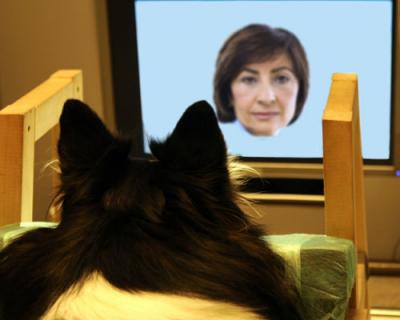Humans have specific brain mechanisms involved in face processing, which focuses attention to faces and recognizes the identity of faces remarkably quickly and accurately. So far the specialized skill for recognizing facial features holistically has been assumed to be a quality that only humans and possibly primates possess. Although it’s well known, that faces and eye contact play an important role in the communication between dogs and humans, this was the first study, where facial recognition of dogs was investigated with eye movement tracking.
Main focus on spontaneous behavior of dogs
Typically animals’ ability to discriminate different individuals has been studied by training the animals to discriminate photographs of familiar and strange individuals. The researchers, led by Professor Outi Vainio at the University of Helsinki, tested dogs’ spontaneous behavior towards images – if the dogs are not trained to recognize faces are they able to see faces in the images and do they naturally look at familiar and strange faces differently?
“Dogs were trained to lie still during the image presentation and to perform the task independently. Dogs seemed to experience the task rewarding, because they were very eager to participate” says professor Vainio. Dogs’ eye movements were measured while they watched facial images of familiar humans and dogs (e.g. dog’s owner and another dog from the same family) being displayed on the computer screen. As a comparison, the dogs were shown facial images from dogs and humans that the dogs had never met.
Dogs preferred faces of familiar conspecifics
The results indicate that dogs were able to perceive faces in the images. Dogs looked at images of dogs longer than images of humans, regardless of the familiarity of the faces presented in the images. This corresponds to a previous study by Professor Vainio’s research group, where it was found that dogs prefer viewing conspecific faces over human faces.
Dogs fixed their gaze more often on familiar faces and eyes rather than strange ones, i.e. dogs scanned familiar faces more thoroughly.
In addition, part of the images was presented in inverted forms i.e. upside-down. The inverted faces were presented because their physical properties correspond to normal upright facial images e.g. same colors, contrasts, shapes. It’s known that the human brain process upside-down images in a different way than normal facial images. Thus far, it had not been studied how dogs gaze at inverted or familiar faces. Dogs viewed upright faces as long as inverted faces, but they gazed more at the eye area of upright faces, just like humans.
This study shows that the gazing behavior of dogs is not only following the physical properties of images, but also the information presented in the image and its semantic meaning. Dogs are able to see faces in the images and they differentiate familiar and strange faces from each other. These results indicate that dogs might have facial recognition skills, similar to humans.
The article was published on 5 December 2013 on Animal Cognition.
Professor Outi Vainio’s research group is based at the Faculty of Veterinary Medicine in the University of Helsinki. The group’s research is focused on phenomenon related to dog cognition. The research of the group is supported by the Academy of Finland and Emil Aaltonen foundation.


